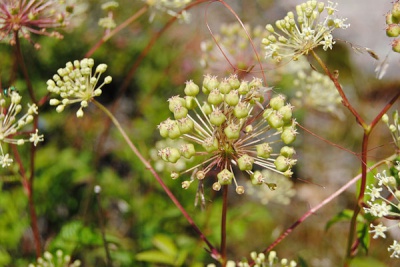Sarsaparilla
Contents
Origin & Description
Sarsaparilla plants are native to the pacific coast of Mexico, but are also commonly found growing in the Himalayas and the more tropical areas of the United States. It is a member of the lily family, and has long tuberous and woody vines that may trail along the ground or climb upward. Small greenish colored flowers and black, blue or red berry-like fruits make this herb an interesting feeding focal point for many birds.
Some other common names are Honduras sarsaparilla, khao yen, saparna, zarzaparilla and jupicanga.
Constituents & Actions
Sasparilla contains saponins and plant sterols such as sarsasapogenin, smilagenin, sitosterol, sarsasaponin, smilasaponin and sarsaparilloside.
This herb acts as an alterative (cleanser, aids in removal of waste products), antiseptic, anti-syphilitic (cures or relieves syphilis or venereal diseases) and aromatic (contains volatile, essential oils which aid digestion and relieve gas).
It's also a blood purifier, carminative (relieves intestinal gas and distension), diaphoretic (causes perspiration and increases elimination through the skin), diuretic (increases the secretion and flow of urine), hormonal and tonic. The bark and the root are mostly used for medicinal purposes.
Medicinal Uses
Sarsaparilla is a blood purifying herb for nitrogen-based waste products such as uric acid. By increasing circulation to rheumatic joints, sarsaparilla is an excellent remedy for gout.
This herb is also very popular when used as a treatment for liver disease, rheumatism, hormone excesses, and skin disorders like psoriasis and eczema.
As a natural steroid for the production of testosterone, it's particularly useful for body building as a source of muscle building hormone. Sarsaparilla is an excellent antidote for poison, and is beneficial in relieving inflammation and gas, also increasing urine flow and perspiration. Some conditions that may be treated with Sarsaparilla are:
- Age spots
- Arthritis
- Blood toxicity (purifier)
- Colds
- Dropsy
- Eczema
- Edema
- Female hormone problems
- Fevers
- Flu
- Gas
- Gout
- Hot Flashes
- Joint pain
- Liver problems
- Prostatitis
- Rheumatism
- Sexual problems
- Skin conditions
- Urinary troubles
- Worms
Culinary Uses
Sarsaparilla alone, or combined with sassafras, are the herbs from which root beer is made. Besides its use in soft drinks, it is also valuable as a tonic, when made into a tea.
Side-Effects
Side effects of sarsaparilla are rare. Excessive use may cause slight gastrointestinal irritation.
